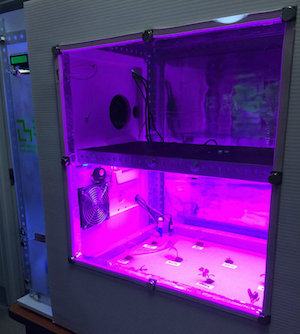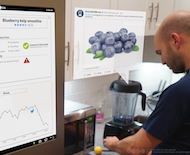Future Now
The IFTF Blog
Food Innovation Recipes: CLOUD INTELLIGENCE
Some recipes are passed down from generation to generation, becoming long-standing traditions. Others invite us to explore new regions or inspire us to reinvent our bodies. They even encourage us to reimagine the food spaces in our lives, from our kitchens to our marketplaces. The power of recipes is the power to combine ingredients in novel ways.
 As we look at the complex global threats we face over the coming decade, from environmental disasters to income inequality to political conflict, we must consider what Institute for the Future calls ingredients for change—capacities, tools, and platforms to reinvent food experiences with the greatest potential for transformation.
As we look at the complex global threats we face over the coming decade, from environmental disasters to income inequality to political conflict, we must consider what Institute for the Future calls ingredients for change—capacities, tools, and platforms to reinvent food experiences with the greatest potential for transformation.
This post gives an overview of one of these ingredients: cloud intelligence. Read more about all five in our forecast report, Food Innovation: Recipes for the Next Decade.
Cloud Intelligence:
Toward decentralized, efficient management of food systems
Agriculture—and the global food system more broadly—is set to be reinvented with the help of low-cost, high-tech methods for connecting food, people, tools, and data together in vast networks. Whether enabling precision-based crop management or empowering home cooks to enlist their appliances in precise food preparation, sophisticated cloud intelligence will create a food system that is more efficient, more productive, and more responsive to shifting social and consumer demands for food.
The rise of the Internet of Things is moving us toward a world in which even the simplest objects can be tracked and managed with stunning levels of precision. With the cost of sensors and other hardware steadily declining, tens of billions of things are coming online in the next decade— including living things such as bees, cows, lettuce, and grapes. A new economy of objects that can negotiate, trade, and market with each other will be automatically responsive to external conditions—ranging from shifting consumer appetites to increasingly volatile climate patterns. Networks of home appliances and wearable devices will communicate directly with large-scale production and distribution systems, expanding the scope of flexible ecosystem management beyond traditional industry boundaries.
The ability to tap into self-managing systems will be accelerated—and democratized—by the emergence of cloud robotics. This term refers to an assemblage of networked robotic systems that can learn from each other. Thanks to the cloud, a robotic system in California will be able to learn from and share cooking techniques with a similar robot in London. As we infuse robotic systems—ranging from tractors and agriculture bots to basic home appliances—with cloud intelligence, innovation will become democratized and shareable.
Over the next decade, cloud-enhanced technologies will shift more of the human labor involved in food production to machines. But in sharp contrast to previous generations of autonomous systems, these technologies— defined by relatively cheap software as much as expensive hardware—will create a playing eld where small-scale producers and manufacturers can compete far more equally with massive-scale operators, and individuals can more readily experiment with and participate in food innovation.
We’ve developed three forecasts for how cloud intelligence will unfold as an ingredient for innovation in the next decade, with signals of change from today.
FORECAST: new measures of quality
From ambiguous data to precise metrics
As the push toward quality continues, particularly in mature markets, intelligent systems will be used to create precision metrics and strategies to optimize freshness, taste, sustainability, and overall perceived quality of food experiences. These systems will offer new ways of engaging and interacting with actors across the food system—from individual plants and animals to eaters. For farmers and growers, these cloud-based systems will provide faster, more precise views into the state of their livestock and crops, enabling early actions that stave off disease outbreaks and ensure peak quality. For traditional manufacturers, they will create new opportunities to meet eaters’ preferences in personalized ways and at the same time increasingly undermine models built on mass-produced food products.
We can see these possibilities through the lens of several signals:
Signal: The FungiAlert sensor developed by two students at Imperial College London is a prototype for a low-cost sensor that detects and signals early signs of crop-damaging phytophthora fungi. It allows farmers to bypass traditional lab testing and take early action to avoid ruining crops, like this image of an infected strawberry plant. These kinds of technologies will empower growers to avoid disease outbreaks and ensure peak freshness and quality at the time of harvest.
Signal: Quantified Ag is one of several new systems designed to network individual livestock using biometric sensors and to help ranchers manage the health of the herd by identifying animals that are most likely to become sick. Systems like this could improve safety and efficiency on farms while also providing in-depth information about the quality of food from the beginning of the supply chain to eaters.
- Signal: Design firm Hirsch & Mann developed a smart spoon for Unilever’s Maille mustard brand that captures shoppers’ flavor preferences, hinting at a future where preferences will be quantified and tracked for personalization. During in-store tasting, individuals tap the smart spoon against RFID sensors associated with their favorite mustard flavors and are given customized recipes and a list of mustard flavors they can later purchase online—and Maille gains a database of customer preferences.

FORECAST: peer-to-peer robotics
From knowledge sharing to automated manufacturing
Small-scale producers are already networked and share political and other resources to attempt to compete more equally with multinational organizations. Likewise, swapping recipes is a time-honored tradition that has already been greatly accelerated by today’s Internet and that has helped further fragment the market into new diets and categories. As robotic systems emerge that can follow recipes and growing instructions with guidance from the cloud, peer-to-peer producers will share knowledge and tools to control these systems. The end result will be innovative food products and experiences that are on par with, and even better than, mass-produced foods.
The signals below hint at the ways in which traditional appliances, enhanced through machine intelligence, will unleash innovative new ways to manufacture food:
Signal: Blossom Coffee is a wireless coffee maker developed by MIT engineers that downloads brewing settings from a database populated by roasters who want to ensure peak flavors of their coffee in homes. It signals a new category of kitchen appliance that automates the cooking process based on precision recipes shared from the cloud. As these appliances emerge, they will simultaneously create new precision methods for cooking and open up new platforms for experimentation and peer-to-peer sharing.
Signal: Innit is a prototype of the next-generation consumer kitchen—completely connected and integrated. The system consists of a combination of relatively cheap sensors and machine intelligence to identify the foods in the kitchen, detect details like the food’s freshness and weight, and then precisely cook the food using recipes from high-end chefs. Innit highlights a future in which machine intelligence moves into our appliances to automate aspects of food preparation and cooking.
 Signal: The MIT Media Lab’s Food Computer is a controlled- environment system that uses robotics for small-scale indoor farming. Climate recipes—collections of settings for carbon dioxide, humidity, and more—can be imported to automatically set the conditions needed by given plants. Part of the new Open Agriculture Initiative, the Food Computer lets anyone tap into a database of recipes that have been successfully tested or experiment regardless of their agricultural expertise or access to resources. MIT is partnering with the World Food Programme to build Food Computers for Syrian refugees in Jordan.
Signal: The MIT Media Lab’s Food Computer is a controlled- environment system that uses robotics for small-scale indoor farming. Climate recipes—collections of settings for carbon dioxide, humidity, and more—can be imported to automatically set the conditions needed by given plants. Part of the new Open Agriculture Initiative, the Food Computer lets anyone tap into a database of recipes that have been successfully tested or experiment regardless of their agricultural expertise or access to resources. MIT is partnering with the World Food Programme to build Food Computers for Syrian refugees in Jordan.
FORECAST: optimized efficiency
From human-managed to self-managing systems
In the next decade, our food markets, like our financial markets, will become dominated by automatic transactions, from negotiating large-scale deals between vendors to automating home orders. As we build out the infrastructure to catalog and manage discrete parts of our food system over the next decade, they will begin to form interoperable, self-managing systems. Producers, distributors, and manufacturers will gain a constantly refreshing and improved database to not only simply reduce inefficiencies but to automate transactions throughout the system—transforming our approaches to everything from production to home purchasing.
Some early signals of self-executing transactions include:
Signal: IBM and Samsung are combining several network technology architectures to build what they call Autonomous Decentralized Peer-to- Peer Telemetry (ADEPT), a protocol to enable things to negotiate with each other. For example, envision a home appliance that communicates with other appliances to negotiate power use. These kinds of self-organizing systems could become the basis of more efficient and flexible manufacturing and distribution systems.
Signal: Amazon’s new Dash Replenishment Service is an application programming interface (API) that hardware manufacturers can build into any new appliance or piece of hardware to identify when supplies are low and automatically reorder from Amazon. For instance, Brita is using this API to detect when its water filters are no longer effectively removing minerals from drinking water and then to trigger an automatic reorder.
Signal: Spread is a Japanese food company that is building a self- managing indoor vertical farm with robotic systems to plant, manage, and harvest 30,000 heads of lettuce per day. Spread’s new technology is far more efficient than traditional agriculture and even its current indoor growing technologies: the “vegetable factory” will use 98 percent recycled water and no pesticides, reliably produce food through controlled climate settings, and through automation deliver locally-grown produce more cheaply.
 ARTIFACT FROM THE FUTURE: Clever Kitchen Agents
ARTIFACT FROM THE FUTURE: Clever Kitchen Agents
This particular Artifact from the Future might be something you would see over the coming decade as Cloud Intelligence revolutionizes the food system. Read about what this image to the right is, and what it means for the future.
HOW WILL YOU CATALYZE FOOD INNOVATION?
Read all of the forecasts and foresight tools in our report, Food Innovation: Recipes for the Next Decade. It explores cloud intelligence and four other ingredients for change—capacities, tools, and platforms to reinvent food experiences with the greatest potential for transformation.

For More Information
For more information on the Food Futures Lab and its research, contact:
Rebecca Chesney | rchesney@iftf.org




